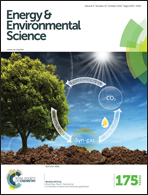Kinetically-enhanced polysulfide redox reactions by Nb2O5 nanocrystals for high-rate lithium–sulfur battery†
Abstract
To combat the shuttle of soluble polysulfides, physical confinement approaches aiming to trap sulfur within porous hosts have been pursued, but their success in terms of capacity decay and kinetic sluggishness is still limited. Herein, we update the confinement approach by integrating ultra-fine Nb2O5 nanocrystals onto a well-developed mesoporous carbon framework, which could primitively combine the advantages of the physical entrapment and the chemical interaction of sulfur species. An electrochemical kinetic study further reveals that the Nb2O5 nanocrystals could serve as an electrocatalyst, significantly accelerating the kinetics of polysulfide redox reactions, especially for the reduction of soluble Li2S6/Li2S4 to insoluble Li2S2/Li2S. By overcoming the kinetic barriers of the redox reactions, the resulting mesoporous carbon microspheres/Nb2O5/S composites have a much improved electrochemical performance in terms of lower polarization, higher Coulombic efficiency, and much improved rate capability. They could deliver a high initial capacity of 1289 mA h g−1 at 0.5C with a reversible capacity of 913 mA h g−1 after 200 cycles. And more importantly, the ternary cathodes demonstrate an unprecedented rate capability with 887 mA h g−1 at 5C, and a reversible capacity of 650 mA h g−1 at 2C after 500 cycles. The concept of accelerating the kinetics of polysulfide redox reactions will pave the way for future development of high-rate and long-cycle Li–S batteries.


 Please wait while we load your content...
Please wait while we load your content...